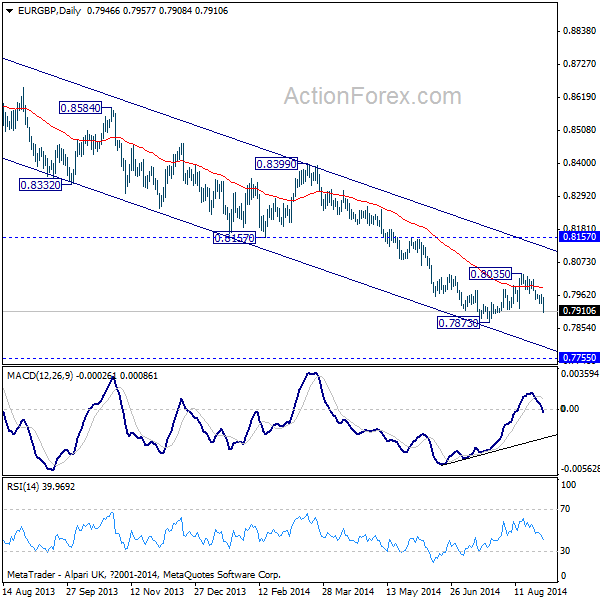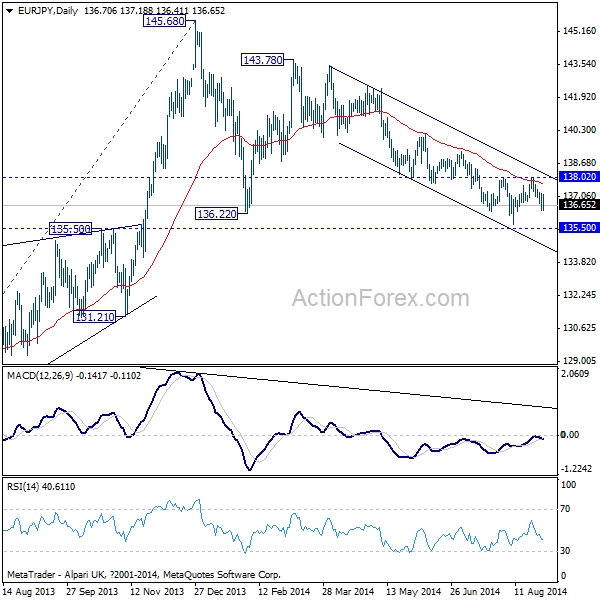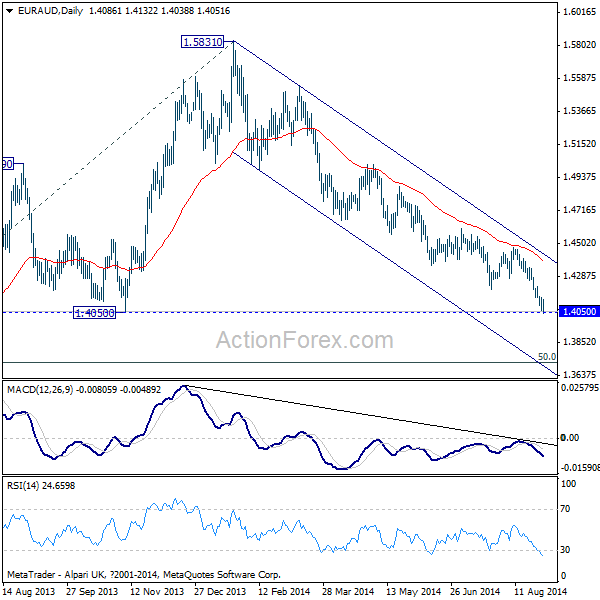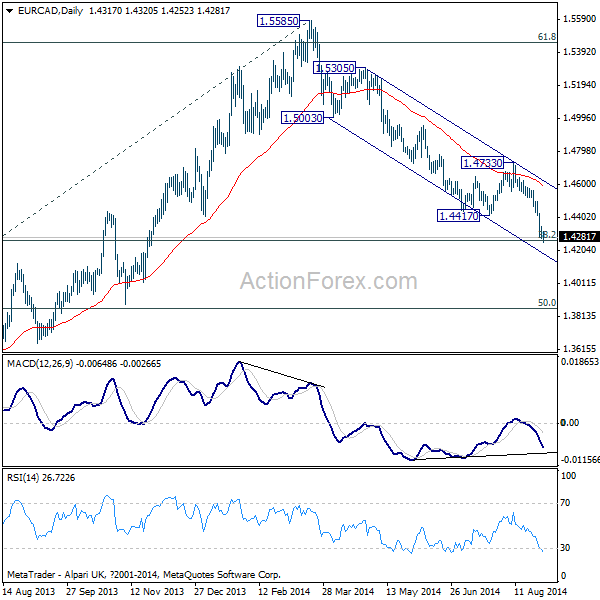Weekly Review and Outlook
Euro Broadly Lower as Focus Turns to ECB
Euro turned into consolidation after initial dip against the greenback last week. But finally, the common currency seemed to have given up on Friday and extended recent decline, closing near the weekly low at 1.3130 against dollar. Indeed, weakness of the euro was rather broad based. In particular, EUR/AUD and EUR/CAD were the two weakest pairs as Aussie and Canadian were both lifted by strength in the stock markets. That was in sharp contrast to Sterling, which remained relatively resilient in crosses even though there was practically no momentum for GBP/USD to stage a meaningful recovery during the week. Dollar and yen were mixed.
Some economists noted that ECB president Draghi's speech in the Jackson Hole symposium in the prior week marked a fundamental shift in ECB's policy. It's perceived that ECB could have finally conceded that inflation expectations are not "well-anchored" any more, and risk of deflation has risen drastically in recent time. In addition to the loss of momentum in Eurozone's economy, there are geopolitical risks, especially in Ukraine. It was noted that Draghi has laid out a strong case for so called coordinated monetary and fiscal expansion as he noted "a coherent strategy to reduce unemployment has to involve both demand- and supply-side policies, at both the euro area and national levels."
Opinions on the timing of quantitative easing from ECB are divided. Some noted ECB would wait until 2015 to launch the QE program while some expected Draghi to do that earlier. But it seemed that the general consensus is ECB would ease more and that triggered some downgrade in the forecast of Euro. For example, Gold Sachs forecast Euro to weaken to parity against dollar by the end of 2017.
The busy week ahead is crucial for the development in EUR/USD. Five central banks will mean, including RBA, BoC, BoJ, ECB, BoE. ECB post meeting conference is the highlight and focus is on whether Draghi would indicate stepping up in preparing for quantitative easing. A number of important economic data will be release from US, including the ISM indices and non-farm payroll. Here are some highlights:
- Monday: China PMI manufacturing; German GDP final; Eurozone PMI manufacturing final; UK PMI manufacturing
- Tuesday: Australia building approvals, RBA rate decision; Swiss GDP; UK construction PMI; US ISM manufacturing
- Wednesday: Eurozone services PMI final; UK services PMI; BoC rate decision; Fed's Beige book
- Thursday: BoJ policy decision; BoE rate decision; ECB rate decision; Canada trade balance; US trade balance, ADP employment; ISM services
- Friday: Eurozone GDP revision; US non-farm payroll; Canada employment, Ivey PMI
Let's take a look at the near term outlook of some euro pairs. EUR/USD's fall from 1.3993 is viewed as a medium term down trend and extended last week. The pair in oversold region as seen in daily RSI. But there is no sign of bottoming yet. Near term outlook stays bearish as long as 1.3221 minor resistance holds and deeper fall should be seen to 161.8% projection of 1.3993 to 1.3502 from 1.3700 at 1.2906 next.

EUR/GBP's sharp fall on Friday sent it through 0.7920 minor support and argues that the corrective recovery from 0.7873 is completed at 0.8035 already. The cross is also staying well inside medium falling channel and the fall is possibly resuming. Initial bias is on the downside this week for 0.7873 support. Break will target 0.7755 key support level next.

EUR/JPY was rejected from 138.02 near term resistance as well as 55 days EMA. Nonetheless, it's staying in range above 135.72 support, and above 135.50 key support level. The outlook is clearly bearish. But as yen was rather weak elsewhere thanks to risk appetites, we'd stay neutral in EUR/JPY in near term until a clear break of 135.50 key support.

EUR/AUD also extended the medium term decline from 1.5831 and breached 1.4050 key support level last week. While, the cross is in oversold region as seen in daily RSI, there is no sign of bottoming. Indeed, reading in the daily MACD suggests that the downside momentum is not exhausted yet and the cross is possibly reaccelerating downwards. We'd be cautiously bearish in the cross and expect deeper fall to 50% retracement of 1.1602 to 1.5831 at 1.3717.

EUR/CAD extended the decline from 1.5585 medium term top and breached 38.2% retracement of 1.2126 to 1.5585 at 1.4264 last week. The cross is also in oversold as see in daily RSI. But daily MACD suggests there would be some more room for downside acceleration. The main question is in deed on whether fall from 1.4733 is the fifth wave of the fall from 1.5585, or something else. But in any case, near term outlook will stay bearish as long as 1.4417 resistance holds. Sustained trading below 1.4264 will pave the way to 50% retracement at 1.3856.

Regarding trading strategies, both our USD/CAD Long and GBP/JPYshort were stopped out as the pairs reversed recent move. Selling Euro is the preferred strategy this week. EUR/GBP was staying in range and since GBP/USD was also weak, we'd avoid this pair. EUR/JPY is avoided too. As EUR/AUD and EUR/CAD are both pressing key support level of 1.4050 and 1.4264 respectively, we'd tend to avoid these two crosses. Thus, we'd sell EUR/USD this week. Nonetheless, we'd tighten up our stop on Thursday before ECB press conference, as well as on Friday before non-farm payroll release.
